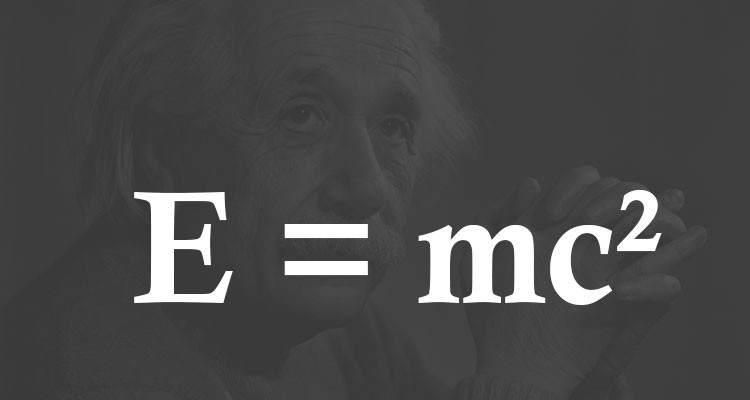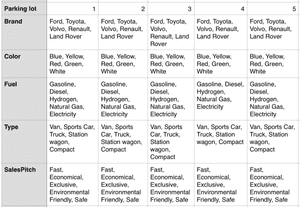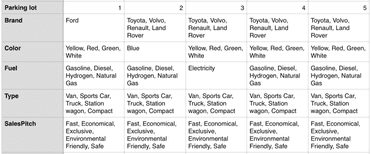In our last blog post, we challenged you with the classic puzzle ”Einstein Riddle”. Did you solve it? Good Job! If you haven’t tried it out yet, go ahead and try to solve it here before you read on.
This blog post is aimed for you who need some more help before you can solve the puzzle.
Without explicitly telling you the answer, it will give you some tips and tricks on how to solve it. You can, however, find the correct answer and the full explanation on how to solve the puzzle in this PDF.
Note: Our version of the Einstein Riddle uses cars instead of people. If you want to use this blog post to solve the original version of the Einstein Riddle, you can transfer the attributes like this:
House: Ford (Norwegian), Toyota (Dane), Volvo (Brit), Renault (German), Land Rover (Swede)
House color: Yellow, Blue, Red, Green, White
Drink: Gasoline (Water), Diesel (Tea), Electricity (Milk), Hydrogen (Coffee), Natural Gas (Beer)
Smokes: Van (Dunhill), Sportscar (Blends), Truck (Pall Mall), Station wagon (Prince), Compact (BlueM)
Pet: Fast (Cat), Economical (Horse), Exclusive (Birds), Environmental friendly (Fish), Safe (Dogs)
How to think when solving the Einstein Riddle
The easiest way is to solve the Einstein Riddle is to start with a 6×5 spreadsheet table with the given rows and information:
As you can see I have already named the parking lots 1 through 5 where 1 is the leftmost parking lot and 5 the rightmost one.
Fill it out with each possible solution in each cell like this:
Now you can start applying the logic from the clues. When you do, there are a few things to remember:
- Some clues will explicitly tell you something in the beginning, like ”The Ford is parked in the First (leftmost) parking lot”. These are the easiest clues since they tell you the car in parking lot #1 IS the Ford. They set the stage for the rest of the clues.
- You cannot solve the puzzle without using deductive logic. For example, if you know the Ford is in parking lot #1, you also know it cannot be in any of the other parking lots. Thus, you can
remove Ford from those. Every time you mark one attribute down, check what kind of options it removes. This is a very important part of solving the puzzle! - Most clues needs to be used in a chronological order. An easy example is ”The Ford is parked next to the Blue car”. It won’t help you until you have put the Ford in parking lot #1. Another example is ”The Green car is parked Left to the White car” which will be very useful further on but is completely useless in the beginning.
- The same clue could be used several times. Just because you have used the clue ”The Compact car runs on Natural Gas” to clear out a few Fuel options it may still be helpful further on to deduct options from the Car Types.
Starting out
As mentioned, we start with the clue ”The Ford is parked in the First (leftmost) parking lot”. With it we can put the Ford in parking lot number 1. Using the clue ”The Ford is parked next to the Blue car” we know that the car in #2 has the color Blue. Thirdly, we can put Electricity as fuel for #3 given ”The car parked in the Center runs on Electricity”. These are our three basic clues.
Since we know that the Electrical car is in the center, the Ford is in #1 and the car in #2 is Blue we also know that no other cars can have those attributes since each attribute is unique. This gives us the following table:
From here on we cannot proceed as quickly but we can start crossing out impossible combinations. Even though these will not single out one specific attribute we can at least remove possibilities from each cell. For example:
”The Volvo is Red” – This clue tells us that the car in #2 is not a Volvo since that car is Blue, i.e. remove the Volvo from those options. We also know that the Ford in #1 cannot be Red so we can remove Red as an option from there.
At this point, you should have all the tools you need to solve the puzzle. Just go through the clue list, one by one and see which kind of combinations it removes. If you still cannot solve it you have at least tried and can use the full cheat sheet.
By now, you may have figured out that the logic used in this puzzle is quite similar to the way the Tacton Configurator works. The clues in this puzzle are similar to the rules (or constraints as we call them) we use in the configurator. The rules are applied to attributes, like Color, Car Type to ensure compatibility between product items. By applying the same type of logic we can come up with not only one solution (as in the puzzle) but the best solution out of thousand possible solutions.
There are however some major differences between the Einstein Riddle and real-life configuration problems. Manufacturers struggle with real-time configuration issues. That’s why it’s time for companies to look at new solutions that enable their sales team to offer the best in class customer experience. That’s easy said than done, but with Tacton Configure, Price, Quote (CPQ) solutions it’s easier than ever to sell your customized products. Check out how Tacton does it with our Smart Commerce platform in The Manufacturers’ Guide to Smart Commerce.




